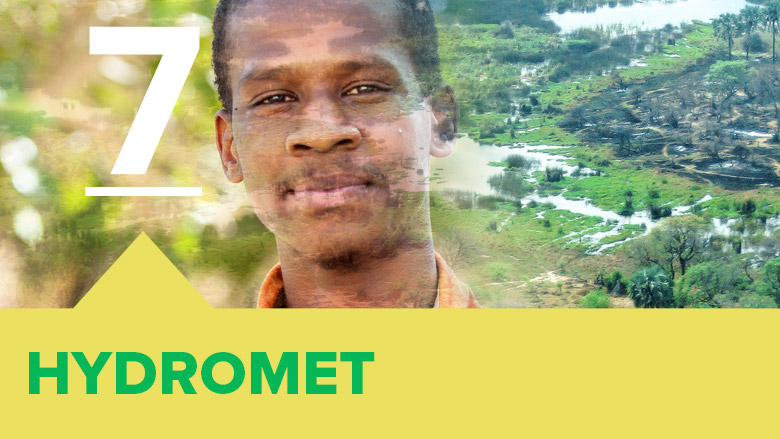Challenge and opportunity
Hydrological and meteorological (or “hydromet”) hazards are responsible for 90% of total disaster losses worldwide. With population growth, rapid urbanization and climate change, this is projected to become more severe. Hydromet services provide real-time weather, water, early warning, and climate information products to end users, based on weather, water and climate data.
Less than 15 years ago, even the small amount of hydromet investment that existed was fragmented, with little hope of producing sustainable results. Governments around the globe are now expressing a demand for better and more effective hydromet services and early warning systems, as success stories continue to highlight their value in saving lives and livelihoods. In addition to their live-saving impact, improved weather forecasting and early warning could increase productivity globally by $30 billion a year, save $13 billion a year in reduced asset losses and save another $22 billion a year in avoided losses.
For the past decade, the World Bank and the Global Facility for Disaster Reduction and Recovery (GFDRR) have been working with partners to increase awareness of, and investments in, reliable and sustainable hydromet services. They have partnered with leading national meteorological services across the globe to strengthen the network of hydromet services. The current portfolio of World Bank hydromet projects, both active and in the pipeline, is about $900 million.
Transformative Action
In Africa, countries have made significant development achievements in the last few decades; annual growth has averaged 4.5 percent, but increasing weather, water, and climate risks threaten these gains. Since 1970, Africa has experienced more than 2,000 natural disasters, with just under half taking place in the last decade. During this time, natural disasters have affected over 460 million people and resulted in more than 880,000 casualties.
Less than 20 percent of Sub-Saharan African countries currently provide reliable weather, water and climate services to their people and economies. African governments often juggle competing priorities for investment, and National Meteorological and Hydrological Services (NMHSs) are rarely prioritized. Inadequate funding inhibits NMHSs from providing the services needed for climate-resilient development and adaptation planning.
To step up hydromet modernization in Sub-Saharan Africa, the World Bank, World Meteorological Organization (WMO) and African Development Bank launched its Africa Hydromet Program in 2015, to support long-term planning for sustainable development and provide reliable and timely early warning services. The partnership now includes UNDP, AFD and WFP.
The regional program aims to improve hydromet services at the national, sub-regional, and Africa-wide levels. At the national level, the program seeks to modernize or build infrastructure such as radar, and automated weather stations, as well as strengthen institutions and service delivery. Sub-regional efforts include standardizing procedures to promote trans-boundary collaboration, while Africa-wide efforts ensure hydromet services across the continent will be linked to regional and global centers, improving data and promoting partnerships.
The World Bank, WMO and GFDRR are also working on the Climate Risk Early Warning Systems (CREWS), launched at COP21 in Paris. This French-led multi-donor initiative aims to finance weather stations, radar facilities, and early warning systems in Least Developed Countries and Small Island Developing States. CREWS has already launched initiatives in Mali and Burkina Faso, and has recently approved additional funding for Niger and Democratic Republic of Congo. In Niger, this will help establish warning systems for rapid-onset events like river and flash flooding. In the Democratic Republic of Congo the project will ensure optimal use of the national meteorological and hydrological service capabilities to protect river navigation, urban development in 10 cities, and agriculture against severe weather.
Expected Results
The first phase of the Africa Hydromet Program will see an investment of approximately $600 million for the modernization of hydromet services and systems in 15 countries and four regional climate centers for the strengthening of early warning and response systems that build resilience against climate and disaster risks.
This program will strengthen national and regional leadership of weather, water and climate services, improve socio-economic benefits of hydromet services and enhance collaboration with private sector, civil society, academia, user groups and other stakeholders.
Key Data Points
- Hydrological and meteorological (or “hydromet”) hazards – weather, water, and climate extremes – are responsible for 90 percent of total disaster losses worldwide.
- The economic cost of recorded weather related disasters in Africa in the last 20 years is estimated at $10 billion. Given the increasing climate variability, these disasters are projected to increase in frequency and intensity.
